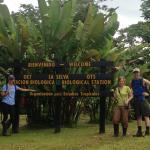Support
During my junior year here at St. Lawrence I arranged to do my Senior Year Experience research project with Dr. Susan Willson. She had been talking with a research station in Costa Rica about the possibility of using their camera trap network for a research project for the past year, and had just decided to go ahead with the project. She and another student applied for funding to travel down to the research station to experience the station first hand, and were awarded with the money to do so. Because of a scheduling conflict with my summer job as a research technician in California, I was initially unable to join them, but after the trip had to be postponed until August, and with the generous donation from the Weaver/Nicolais Family International Travel Endowment Fund, I was able to join them.
Our project was designed to monitor terrestrial vertebrates in Costa Rica using a network of camera traps. Camera traps take pictures of anything that moves in front of them, and are left in place for years at a time, while being checked regularly. They are becoming a very common tool for studying large terrestrial vertebrates where it is difficult for people to follow and track them unhampered, such as the rainforest. Because few people have done these studies, we were able to select any subject animal we wanted. I chose to focus my research on pumas, or mountain lions, since they are large vertebrates that are prevalent throughout North and South America. However, very quickly, it became clear that the research station we planned to visit was not nearly as well equipped as they initially made it seem. Their camera trap network was not aligned in such a way that they would be able make use of their data in any useful fashion. We re-evaluated our project, and decided to travel instead to La Selva Biological Station, also in Costa Rica.
At La Selva, we stayed in dormitories, and ate our meals in a dining hall. There were very few researchers there, so we basically had the entire station to ourselves. The station is located on a big preserve in the middle of the lowland rainforests of Costa Rica, along a large river that bisects the campus. For most of our stay, we occupied ourselves exploring the station’s network of trails to familiarize ourselves with tropical rainforests. While I was not able to find any pumas, I did encounter a plethora of other wildlife, including some wild birds such as kingfishers, ibises, motmots, tanagers, and parrots that I had never seen before. Wild peccaries, small pig like mammals, roamed around the trails in groups, and amphibians and reptiles were always lurking in the trees nearby. The context I have gained from this trip will be vital to my Senior Year Experience. Now, I have a first hand understanding of the habitat that I will be studying for the rest of the year.
